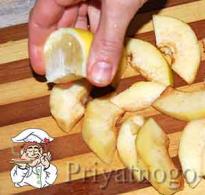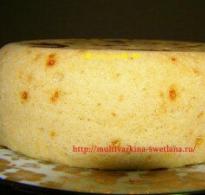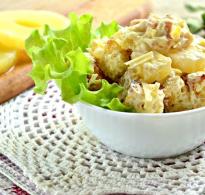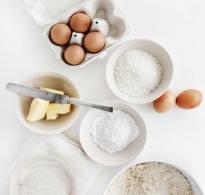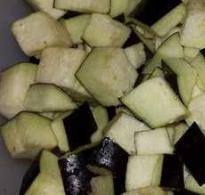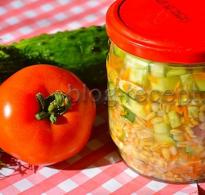What is the difference between royal champignons and simple ones? Royal champignons: kebab, French appetizer
It sounds like the title of a story about some guy from a southern European seaside town :) In fact, translated into ordinary language it is “a dish called “julienne”, made from brown mushrooms.”
Portobello, "royal mushrooms".
The toponym “Portobello” also exists: this is the name of one of the urban areas of Dublin, the capital of Ireland (Portobello, “beautiful harbor”, translated from Italian). I have not yet fully figured out why these mushrooms were given such a name, but the fact that they are beautiful is for sure! I don't know what they have to do with Dublin (although it is clear that Portobello is not an English word), but they have an Italian footprint.
Portobello mushrooms belong to the genus of champignons, which has the botanical name Agaricus bisporus. The earliest description of their industrial cultivation is said to have been given by Joseph Pitton de Tournefort in 1707.
It is believed that champignons came to the rest of Europe from Italy through Switzerland and France. These mushrooms can have cap sizes from 3 to 10-12 cm and exist in three varieties: cream, white and brown (the last two are found in nature).
Champignons with brown caps also called "Swiss brown mushroom", "Roman brown mushroom", "Italian brown", "Italian mushroom". There are names like “portobello mushroom” or simply “portobello”/ “portabella”, “portabello”. At the same time champignons with white caps are simply called "champignons", "mushroom", "button mushroom", "white mushroom", "cultivated mushroom", "table mushroom", "pizza mushroom", "champignon mushroom".
Large brown champignons are also called “royal”, but the most important thing for them is not only color and size. The main thing is the aroma and taste, which for some reason are absent in white champignons of different sizes. At least from the ones we bought and tried. I will also clarify this nuance when necessary.

The caps of these white champignons have a diameter of 10-11 cm, but for some reason they are not as fragrant as the brown ones. Next to them in the photo is a large walnut.
Note: there are more than 200 (!) species in the champignon genus, some of which are inedible and even toxic. It is customary to use unripe mushrooms with closed (rounded) caps for food. As they ripen, the caps of the champignons open, and they become similar to other mushrooms we are familiar with. There are also especially large champignons, the cap of which reaches a diameter of 25 cm.

This is what champignons look like when ripe. Photo: botit.botany.wisc.edu. There you can also read about the industrial cultivation of champignons (article in English).
For reference: Portobello mushrooms are not called “royal” mushrooms everywhere or always. Or rather, as always, there is some confusion. Sometimes small brown champignons are also called “royal”, but this is the official name for another type of mushroom: Royal Trumpet Mushroom, botanical name Pleurotus eryngii; steppe or royal oyster mushroom. These mushrooms are also called "king trumpet mushroom", "French horn mushroom", "king oyster mushroom", "king brown mushroom", "boletus of the stepspes", "trumpet royale".
Royal oyster mushroom is found naturally and is currently cultivated on an industrial scale in Japan, Australia, South Africa, Taiwan, China, South Korea, Italy and the USA. It looks like this:

Photo: Wikipedia (link active)
The common name “portobello” is assigned specifically to brown champignons, which have different sizes. Cream mushrooms are sometimes called "crimini" and white ones are simply called "champignons".
Regarding julienne, then I’ll honestly say that I didn’t cook it until recently. And we didn’t really like the champignons: they seemed tasteless to us until we tried them brown king size :)
Portobello Julienne
Naturally, to prepare this dish you can use regular champignons, and even any other mushrooms to your taste. I also cooked with large white champignons.

I like to use large mushrooms because they are easier to work with, but the taste and aroma are more pronounced in brown ones. It’s not for nothing that they are still called “royal” in some places.
I took the recipe that I liked best, plus it came with a video.
First, I’ll tell you how best to handle champignons, incl. large:
1) Even raw portobellos have a pleasant aroma, which distinguishes them from other mushrooms;
2) Dark "gills" can discolor the dish, so they can be carefully removed (scraped) with a spoon.
3) It is better not to wash the champignons, but to wipe them with a paper towel or thin cloth. In this form, they can be stored in the refrigerator for about a week (it is better to store not in plastic, but in a paper bag);
4) if there is a need to wash the champignons, this can be done in cool water by rubbing them with your hands. It is not advisable to store washed mushrooms; they should be cooked immediately.
5) There are some comrades who do not eat anything in mushrooms except caps, i.e. all other parts are considered garbage :) Mushroom legs, of course, are tough, so they need to be well fried or cooked longer. I make julienne from the caps, and leave the legs for soups and other dishes. I recently showed one of the soups: (link will open in a new window).
"Classic mushroom julienne"
Original recipe from www.eda.ru
Start of quote. " Ingredients:
Champignons 100 g
Onions 2 heads
Wheat flour 1 teaspoon
Butter 2 tablespoons
Cream 50 ml
Hard cheese 50 g
Salt to taste
Ground black pepper to taste
Preparation:
1. Chop onions and mushrooms, fry with salt and pepper in butter. Add flour and stir.
2. Place the mushroom mixture in molds, pour in cream, sprinkle with grated cheese and bake in the oven at 180 degrees for 20–25 minutes." (end of quote)
Sometimes I fry mushrooms in a mixture of butter and vegetable oil, sometimes I don’t use flour. I prefer to use low-fat cream, about a tablespoon per serving (I pour it over the mushrooms, and then put cheese on top, passed through a coarse grater). If you’re not too lazy, you can make bechamel sauce for julienne, but I prefer to cook lasagne with it.
And a nice video that shows in detail all the stages of preparation associated with the cited recipe (duration 3 minutes):
My son calls Julienne of Royal Champignons the best dish I “ever cooked.” That's what he said. This is not counting lasagna, pizza and other “male sweets” :)
By the way, Contrary to popular belief, mushrooms do NOT contain large amounts of proteins (amino acids), but I'll tell you about this another time.
Prepared for mine
A savory appetizer can be prepared for a holiday or meeting guests.
Preparation:
- Cut the stems from the caps, salt them and fry them in vegetable oil. Place the blanks on parchment.
- Chop the garlic, herbs and mushroom stems. Fry the food for 1 minute in the same pan.
- Cut the cheese into slices and place them on the mushroom caps. Place greens and garlic on top.
- Bake the pieces in an oven preheated to 175°C for 15 minutes.
Serve the treat with wine or champagne.
Salmon with royal mushrooms and potatoes
Noble mushrooms go well with red fish and vegetables.
Ingredients:
- salmon steaks – 2 pcs.;
- champignons – 4 pcs.;
- potatoes – 2 pcs.;
- soy sauce – 120 ml;
- lemon – 1 pc.;
- seasoning for fish – 30 g;
- rosemary and white pepper - to taste.
Preparation procedure:
- Mix soy sauce with seasoning and spices. Rub the steaks with marinade and leave them in the refrigerator for 1 hour.
- Cut the potatoes into slices and the mushrooms into slices.
- Place prepared vegetables and mushrooms on 2 sheets of foil. Place the fish on them and pour lemon juice over them.
- Wrap the pieces in foil and place in an oven preheated to 180°C for 25 minutes. The dish can also be grilled over hot coals.
The hot dish can be complemented with a salad of fresh or stewed vegetables.
Cream soup of royal champignons
The aromatic dish is served with white bread croutons and herbs.
Ingredients:
- champignons – 600 g;
- chicken broth – 500 g;
- cream 20% - 200 g;
- onions – 2 pcs.;
- flour – 60 g;
- sunflower oil – 60 g;
- butter – 20 g;
- salt and pepper - to taste.
Preparation:
- Cut the mushrooms and onions into cubes and fry them until tender. Add salt and pepper.
- Pour 150 g of broth over the products and grind them with a blender.
- Fry the flour in butter in a saucepan. Add the mushrooms and pour in the remaining broth.
- Boil the soup and cook for 7 minutes. Pour in the cream and cook for another 5 minutes.
Serve the dish hot.
How do royal champignons differ from regular champignons?
This variety of mushroom is cultivated all over the world. Mushrooms are grown in greenhouses and open ground, and can also be found in forests and fields from May to September.
- brown color of the cap;
- dense fleshy pulp;
- pronounced taste and aroma of wild mushrooms.
These mushrooms can be dried and pickled, just like regular ones.
Champignons are added to the filling for pies and pizza.
It differs from the more common white champignon in the color of the cap and a richer mushroom taste and aroma. Many people prefer this particular type of champignon, equating its taste to the porcini mushroom. Constant consumption of champignons reduces the risk of heart attack and prevents the appearance of atherosclerosis, improves memory, activates mental activity, and helps avoid migraines and headaches. The cap is brown, smooth, sometimes scaly, 5-10 cm in diameter, round at first, becoming flatter with age. The plates are white or pink, later darkening. The leg is smooth and dense. In young champignons, the edges of the cap are connected to the stem by a solid white blanket, which later comes off, forming a solid round ring on the stem. The pulp is white, with a pronounced mushroom taste. Champignons are dried, frozen, and prepared into aromatic soups, side dishes and sauces.
Breeding tips: Grow all year round in dark, ventilated areas. To prepare the substrate, it is recommended to mix 4 liters of soil for flowers, 2 liters of horse manure, 150 g of chalk, 100 g of gypsum, 100 g of potassium superphosphate, 50 g of ammonium nitrate and add a solution of water with quicklime (per 0.8 liter of water 10 g of quicklime lime). The substrate is left for three days, mixing the layers every day. During this time, the sterilization process takes place, as evidenced by the heating of the soil mixture. When the temperature of the substrate stabilizes at +25°C (on the 3rd day), it is ready for use. This volume is calculated for 1 package of mycelium.
Growing and care:
1. The finished substrate is carefully mixed with mushroom mycelium and distributed along the bottom of the container (box or plastic bag). The optimal layer of substrate is 5-8 cm. Gently water it (when the substrate is compressed, a wet mark should remain on the palm) and cover with a film in which holes are made for air access. The temperature is constantly maintained at 22-24°C.
2. Within 35 days, the substrate becomes overgrown with mycelium. As necessary, the substrate is moistened from a sprayer.
3. When white, cobwebby threads appear on the surface of the substrate, it is sprinkled with a covering mixture of soil and chalk (9:1) 2 cm thick and covered again with film. After 5 days, the film is removed and the temperature is reduced to 14-17°C.
4 . Over the next month, the substrate is constantly moistened with a sprayer, so that the moisture remains on the casing soil.
Fruiting: 2.5 months after planting, the first mushrooms will appear. After each harvest, it is recommended to let the substrate “rest” (water and raise the temperature to +24°C), after a week reduce the temperature to +16°C and with constant watering, fruiting will begin again. Fruits in waves for 6 months. Productivity: Up to 1 kg per container for the entire growing period. Ingredients: mycelium of the "Royal champignon (brown)" mushrooms in the substrate. Store the unopened package in a cool, dry place, possibly in the refrigerator at a positive temperature.
Packaging: 15 ml mycelium on grain substrate
Kira Stoletova
There are many varieties of champignons, but the royal champignons are considered the most delicious and attractive. Unlike the usual white ones we are used to, they have a brown tint to the cap and are large in size. In addition, they last longer and have a rich aroma. Their taste is reminiscent of porcini mushroom.

Appearance of the mushroom
The cap of the royal champignon, or as it is also called the bisporous or brown champignon, has a hemispherical shape with a characteristic small depression in the center, its edges with the remnants of the cover are folded inward. These mushrooms differ from ordinary ones in their light brown color and brown spots. There are artificially bred strains with smooth white and cream caps.
The diameter of the cap reaches 7-15 cm, sometimes 25-30 cm in diameter. The plates have a gray-pink color with a brownish tint. The spore powder is brown in color.
Irina Selyutina (Biologist):
Young specimens are characterized by the presence of a dense, light-colored veil covering the hymenophore plates. As the mushroom matures, it breaks and as a result a continuous ring is formed on the stem. The plates of the hymenophore are initially gray-pink and gradually become not just dark brown, but acquire a purple tint.
By the way. The royal champignon species is characterized by a long growth period - 2-3 months.
The leg has the shape of a cylinder, narrowed at the base, and is 2-3 cm wide and 4-8 cm long. It is smooth to the touch, its color matches the color of the cap.
The pulp is white in color, but turns pink when cut.
Useful properties
Royal champignon contains in its pulp many useful elements that have a positive effect on the body. Consumption of these mushrooms:
- speeds up the functioning of the digestive tract;
- improves appetite;
- prevents the formation of blood clots;
- slows down the aging of the body;
- affects the heart and blood vessels, reducing the risk of heart attack;
- relieves inflammation;
- has an expectorant effect;
- optimizes brain function;
- removes toxins from the body.
Contraindications
This species is classified as a heavy food due to the presence of chitin in the pulp. This substance is not absorbed by the body, so mushrooms are poorly digested. Therefore, you should not give these mushrooms to children under 12 years of age. It is advisable to eat royal champignon 3 times a week. You should stop using it if you have the following diseases:
- pancreatitis;
- ulcer;
- hepatitis;
- flatulence;
- indigestion;
- cholecystitis;
- enterocolitis.
Like other species, royal champignons are mushrooms that actively absorb toxic substances from the soil, so you should not collect them near highways and industrial enterprises. It is better to buy artificially grown mushrooms.
Application
In cooking

Young mushrooms are mainly used for food because they have a more delicate taste and pleasant smell.
Before you start cooking, the mushrooms are thoroughly cleaned of soil and washed. You should not leave them in water for a long time, because... they may lose their taste and aroma. When cleaning, cut off the film (private cover) that connects the stem and cap.
If the mushrooms are boiled in advance, they are added to the dish at the final stage of cooking. Large mushrooms are used for frying and baking, medium-sized ones are often left for fillings, and small ones are used for pickling.
Champignons can be eaten raw. They are added to a variety of salads or prepared into sauces. For a more pleasant taste, sprinkle them with a little lemon juice. To safely consume raw champignons, rinse them in running water and dry them, then cut them into thin slices. You should not store fresh chopped mushrooms for too long, as they lose their beneficial properties and taste.
To prepare pickled mushrooms take:
- fresh champignons – 700 g;
- onion – 150 g;
- vegetable oil – 50 ml;
- vinegar – 25 ml;
- dill;
- garlic, bay leaf, pepper, salt - to taste.
Wash the mushrooms and fry for 2-3 minutes without adding oil. When the product begins to release juice, add the remaining ingredients except dill. The dish is brought to a boil, removed from the heat and sprinkled with herbs. Then the mushrooms should brew for several hours under the lid. Marinated champignons are served cold.
Another popular cooking method is canning. To do this, take the following ingredients:
- water – 1 l;
- bay leaf – 6-7 pcs.;
- salt, sugar, vinegar, vegetable oil - 1 tbsp each;
- cloves, allspice - to taste.
For preservation, medium-sized mushrooms are taken; it is important that they do not have even minimal damage. They are washed well and soaked for 10 minutes in a solution with the addition of citric acid. When they sink to the bottom, they are taken out, cooled and filled with salt water. Then, along with the spices, they put them in jars; the containers should be 80% filled. Afterwards they are poured with marinade, covered with a lid, left to pasteurize for 20 minutes and rolled up.
In medicine
Champignons are also useful in medicine: they contain little fat and carbohydrates, so they are often used in the diet menu. They also lower the amount of sugar in the blood, which is why they are included in the diet of diabetics.
Due to its ability to have an expectorant effect, royal champignon is useful for asthma, bronchitis and tracheitis. A large amount of riboflavin and thiamine in the composition stops migraines and headaches.

An extract is prepared from this product, which helps with disorders (injuries) of the epidermis. Unwashed fresh mushrooms are used to prepare this medicine. They are cut into small pieces, placed in a jar and filled with olive oil. Next, the jar is placed in the refrigerator for 4 hours and taken out every 60 minutes to hold in a water bath for 2-3 minutes.
Afterwards, the mixture is filtered, the mushrooms are used in food, and the oil is stored in the refrigerator. This product is used to treat the affected areas of the skin 3 times a day. The treatment period lasts 2-3 months.
Growing methods
This species is also grown at home, but this is a labor-intensive process that requires a cool room with high humidity.
Irina Selyutina (Biologist):
Since champignons are not demanding on the amount of light during development, any premises (basements, barns, greenhouses) in which the air humidity is 60-90% are perfect for growing them. At the same time, it is important to take into account the year-round temperature indicators in them: if in winter it is at least +10℃, and in summer not higher than +20℃, then the room will be suitable for year-round cultivation of royal champignons. If these temperature conditions are not maintained, mushrooms can only be grown in them seasonally.
Compost made from wheat or rye (necessarily without traces of mold) and horse manure is used as a substrate. To grow you need the following:
Royal champignon or umbrella mushroom. Mushrooms of the Krasnodar region 2018.
Poisonous champignon, www.grib.tv
Conclusion
Royal champignons are a popular type of mushroom. They have a delicate taste and pleasant smell. They are used for preservation, pickling and eaten raw. They are used in medicine because... they have a useful composition and help as a means of complementary therapy in the treatment of many diseases. Some people grow them at home, but it is not an easy process.
The professional production cycle includes all stages: from the formation of compost to the actual production of fresh champignons. Only large champignon farms have full knowledge of this technology; smaller ones, farmers, buy ready-made compost and are engaged in forcing fruiting bodies - mushrooms. For an amateur who wants to grow mushrooms at home, only forcing is also available. Although, of course, it will be difficult to achieve impressive success.
And here's why:
1. To grow champignons, you need a special room without light with variable climatic characteristics
Inside special complexes, practically sealed cultivation chambers, or cultivation halls, are installed - light-tight rooms with air-conditioned air. Inside each room, special racks with a prepared substrate are placed in several rows - compost with mushroom mycelium seeded.
Compost and mycelium
One of the essential elements of mushroom compost is grain straw. Gypsum and chicken manure are used as additives. When preparing, the presence of pests and pathogens is completely excluded. The straw is soaked, mixed with additives and composted throughout the year. At the last stage, the mycelium is formed.
You can order from 0.2 kg of champignon mycelium on a grain substrate via the Internet or by mail. It costs about 200-300 rubles, plus delivery. But be careful, the mycelium dies at temperatures above +33 °C and completely dry. If storage conditions are not met, nothing will grow.
2. It is necessary to change climatic parameters at different stages of mycelium development
Champignons are a rather capricious crop, and for each stage of development it is necessary to maintain a certain temperature and humidity. At all stages of cultivation, which take approximately 3 months (the full cycle from compost to finished products), the microclimatic parameters in the halls are constantly changing. So, at one of the initial stages of growth, compost with mycelium is kept warm and watered abundantly, pouring up to 30 liters per 1 square meter. m. Literally after 2-3 days, the conditions in the chamber change (they lower the humidity and temperature), thereby regulating the number of fruit ovaries formed.
Mushroom requirements:
. darkness;
. humidity;
. rich, fertile compost.
3. Sterility of the room where mushrooms are grown
After the end of each growing cycle, the racks and walls are thoroughly washed and only after that a new forcing begins. Fungal infections are transmitted quickly, so specialists constantly monitor the condition of the compost and fungi. At the first sign of infection, measures are taken immediately. In addition, sources of pollution and danger for cultivated mushrooms are the substrate workshop (gassed exhaust air and the spores of pathogenic fungi contained in it) and the warehouse of used substrate. Ideally, the production and landfill are sufficiently remote from the main production.

4. The champignon harvest takes place in several waves
2.5-3 weeks after loading the racks, the harvest begins, which lasts about a month and includes 2 harvest waves. The first wave of fruiting lasts about 6-7 days. The largest harvest (about 70%) occurs in the first two waves. In professional farms, after the second wave, all compost is removed and transported to landfills; in private and small farms, up to 4 waves of harvests are harvested.
At the dacha, you can collect 8-15 kg of champignons from 1 square meter; professionals collect up to 25-30 kg.

5. After harvesting, mushrooms continue to grow
After collection, the mushrooms are processed in a vacuum chamber and cooled for 8-12 hours, since even cut mushrooms continue to grow in the heat, using their own nutritional elements. Therefore, if you grow mushrooms yourself, you need to consume them immediately.
Popular questions about champignons
Can champignons be eaten raw?
If all growing conditions are met, the fruiting bodies of the champignons are not treated with anything; the picker collects them with gloves in one touch, trying to practically not touch the cap. Therefore, in the production itself, pickers and technologists eat mushrooms directly from the “bed”, without even washing them. Home-grown champignons can also be eaten straight from the garden.
What are king mushrooms and portobello mushrooms? How are they different from ordinary champignons?
The royal champignon differs from the usual one in the color of the cap (it is brown) and a more pronounced mushroom taste and aroma. Portobello are the largest champignons, the diameter of the cap reaches 10-15 cm, so they are ideal for stuffing. Interestingly, the name “portobello” essentially means nothing, it’s just a good advertising ploy designed to draw attention to these mushrooms.

Which mushrooms taste better?
The champignon gradually gains taste and aroma; an open mushroom is a mature mushroom, in which the taste qualities are most clearly manifested. Champignons with a diameter of 4-5 cm are best suited for frying and cooking soup.
Is it possible to use compost after mushrooms in a regular household?
Can! For champignon production, compost of the third stage is specially prepared, which is disinfected and saturated with nutrients. It is absolutely safe for plants, it can be used for mulching and as a component of soil for planting vegetable and flower crops.
The best spring diet for girls from mushrooms
The good news for ladies is that one serving of champignons (4-5 medium-sized mushrooms) contains only 20-25 kcal and 0 g of fat. In addition, champignons contain nutrients, vitamins and trace elements (copper, B vitamins), antioxidants (selenium and ergothioneine) and amino acids.
At the same time, white champignons contain a small amount of vitamin D, but it is very necessary for us, especially in spring.

